Cakewalk V-STUDIO 20 Manual
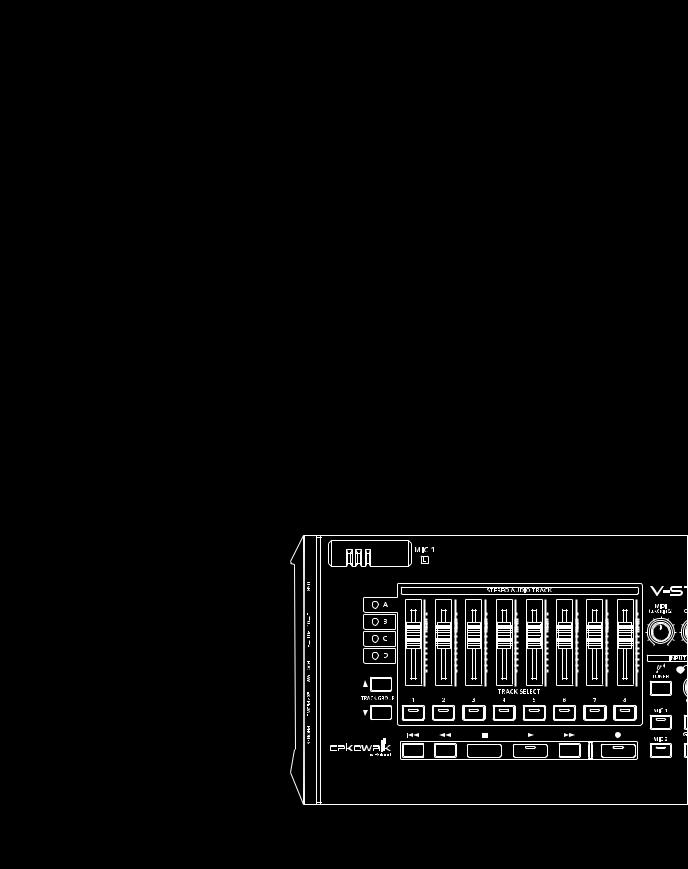
Owner’s Manual
 HARDWARE GUIDE
HARDWARE GUIDE

Before using this unit, carefully read the sections entitled: “USING THE UNIT SAFELY” (p. 3) and “IMPORTANT NOTES” (p. 5). These sections provide important information concerning the proper operation of the unit. Additionally, in order to feel assured that you have gained a good grasp of every feature provided by your new unit, Owner’s Manual should be read in its entirety. The manual should be saved and kept on hand as a convenient reference.
*Microsoft, Windows and Windows Vista are registered trademarks of Microsoft Corporation.
*The screen shots in this document are used in compliance with the guidelines of the Microsoft Corporation.
*Windows® is known officially as: “Microsoft® Windows® operating system.”
*ASIO is a trademark of Steinberg Media Technologies GmbH.
*Cakewalk is a registered trademark of Cakewalk Inc.
*Cakewalk logo is a trademark of Cakewalk Inc.
*MMP (Moore Microprocessor Portfolio) refers to a patent portfolio concerned with microprocessor architecture, which was developed by Technology Properties Limited (TPL). Roland has licensed this technology from the TPL Group.
*All product names mentioned in this document are trademarks or registered trademarks of their respective owners.
Copyright © 2010 ROLAND CORPORATION
All rights reserved. No part of this publication may be reproduced in any form without the written permission of ROLAND CORPORATION.
2

Used for instructions intended to alert the user to the risk of death or severe injury should the unit be used improperly.
Used for instructions intended to alert the user to the risk of injury or material damage should the unit be used improperly.
* Material damage refers to damage or other adverse effects caused with respect to the home and all its furnishings, as well to domestic animals or pets.
•Do not open or perform any internal modifications on
the unit.
....................................................................................................................
•Do not attempt to repair the unit, or replace parts within it (except when this manual provides specific instructions directing you to do so). Refer all servicing to your retailer, the nearest Roland Service Center, or an
authorized Roland distributor, as listed on the “Information” sheet.
....................................................................................................................
• Never install the unit in any of the following locations.
• Subject to temperature extremes (e.g., direct sunlight in an enclosed vehicle, near a heating duct, on top of heat-generating equipment); or are
•Damp (e.g., baths, washrooms, on wet floors); or are
•Exposed to steam or smoke; or are
•Subject to salt exposure; or are
•Humid; or are
•Exposed to rain; or are
•Dusty or sandy; or are
•Subject to high levels of vibration and shakiness.
....................................................................................................................
The  symbol alerts the user to important instructions or warnings.The specific meaning of the symbol is determined by the design contained within the triangle. In the case of the symbol at left, it is used for general cautions, warnings, or alerts to danger.
symbol alerts the user to important instructions or warnings.The specific meaning of the symbol is determined by the design contained within the triangle. In the case of the symbol at left, it is used for general cautions, warnings, or alerts to danger.
The  symbol alerts the user to items that must never be carried out (are forbidden). The specific thing that must not be done is indicated by the design contained within the circle. In the case of the symbol at left, it means that the unit must never be disassembled.
symbol alerts the user to items that must never be carried out (are forbidden). The specific thing that must not be done is indicated by the design contained within the circle. In the case of the symbol at left, it means that the unit must never be disassembled.
The ● symbol alerts the user to things that must be carried out. The specific thing that must be done is indicated by the design contained within the circle. In the case of the symbol at left, it means that the power-cord plug must be unplugged from the outlet.
•Make sure you always have the unit placed so it is level
and sure to remain stable. Never place it on stands that could wobble, or on inclined surfaces.
....................................................................................................................
•This unit, either alone or in combination with an amplifier and headphones or speakers, may be capable of producing sound levels that could cause
permanent hearing loss. Do not operate for a long period of time at a high volume level, or at a level that is uncomfortable. If you experience any hearing loss or ringing in the ears, you should immediately stop using the unit, and consult an audiologist.
....................................................................................................................
•Do not allow any objects (e.g., flammable material, coins, pins); or liquids of any kind (water, soft drinks, etc.) to penetrate the unit.
....................................................................................................................
3
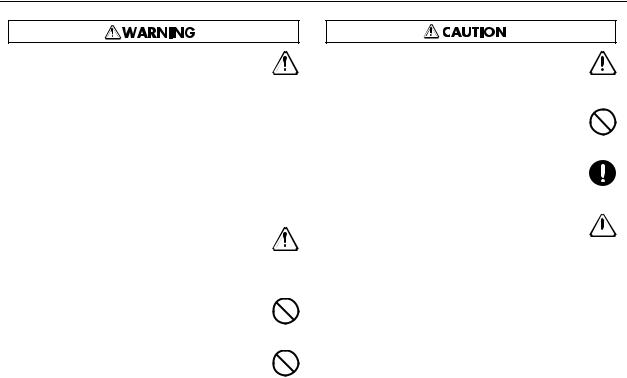
USING THE UNIT SAFELY
•Immediately turn the power off, and request servicing
by your retailer, the nearest Roland Service Center, or an authorized Roland distributor, as listed on the “Information” sheet when:
•Objects have fallen into, or liquid has been spilled onto the unit; or
•If smoke or unusual odor occurs
•The unit has been exposed to rain (or otherwise has become wet); or
•The unit does not appear to operate normally or exhibits a marked change in performance.
....................................................................................................................
•In households with small children, an adult should
provide supervision until the child is capable of following all the rules essential for the safe operation
of the unit.
....................................................................................................................
•Protect the unit from strong impact. (Do not drop it!)
....................................................................................................................
•DO NOT play a DVD-ROM disc on a conventional audio CD player. The resulting sound may be of a level that could cause permanent hearing loss. Damage to speakers or other system components may result.
....................................................................................................................
•Try to prevent cords and cables from becoming
entangled. Also, all cords and cables should be placed so they are out of the reach of children.
....................................................................................................................
•Never climb on top of, nor place heavy objects on the unit.
....................................................................................................................
•Disconnect all cords coming from external devices
before moving the unit.
....................................................................................................................
•Always turn the phantom power off when connecting
any device other than condenser microphones that  require phantom power. You risk causing damage if you mistakenly supply phantom power to dynamic microphones, audio playback devices, or other devices that don’t require such power. Be sure to check the specifications of any microphone you intend to use by referring to the manual that came with it.
require phantom power. You risk causing damage if you mistakenly supply phantom power to dynamic microphones, audio playback devices, or other devices that don’t require such power. Be sure to check the specifications of any microphone you intend to use by referring to the manual that came with it.
(This instrument’s phantom power: 48 V DC, 10 mA Max)
....................................................................................................................
4


 Important Notes
Important Notes
Power Supply
•Before connecting this unit to other devices, turn off the power to all units. This will help prevent malfunctions and/or damage to speakers or other devices.
Placement
•Using the unit near power amplifiers (or other equipment containing large power transformers) may induce hum. To alleviate the problem, change the orientation of this unit; or move it farther away from the source of interference.
•This device may interfere with radio and television reception. Do not use this device in the vicinity of such receivers.
•Noise may be produced if wireless communications devices, such as cell phones, are operated in the vicinity of this unit. Such noise could occur when receiving or initiating a call, or while conversing. Should you experience such problems, you should relocate such wireless devices so they are at a greater distance from this unit, or switch them off.
•Do not expose the unit to direct sunlight, place it near devices that radiate heat, leave it inside an enclosed vehicle, or otherwise subject it to temperature extremes. Excessive heat can deform or discolor the unit.
•When moved from one location to another where the temperature and/or humidity is very different, water droplets (condensation) may form inside the unit. Damage or malfunction may result if you attempt to use the unit in this condition. Therefore, before using the unit, you must allow it to stand for several hours, until the condensation has completely evaporated.
•Depending on the material and temperature of the surface on which you place the unit, its rubber feet may discolor or mar the surface.
You can place a piece of felt or cloth under the rubber feet to prevent this from happening. If you do so, please make sure that the unit will not slip or move accidentally.
Maintenance
•For everyday cleaning wipe the unit with a soft, dry cloth or one that has been slightly dampened with water. To remove stubborn dirt, use a cloth impregnated with a mild, nonabrasive detergent. Afterwards, be sure to wipe the unit thoroughly with a soft, dry cloth.
•Never use benzine, thinners, alcohol or solvents of any kind, to avoid the possibility of discoloration and/or deformation.
Additional Precautions
•Use a reasonable amount of care when using the unit’s buttons, sliders, or other controls; and when using its jacks and connectors. Rough handling can lead to malfunctions.
•When connecting / disconnecting all cables, grasp the connector itself—never pull on the cable. This way you will avoid causing shorts, or damage to the cable’s internal elements.
•To avoid disturbing your neighbors, try to keep the unit’s volume at reasonable levels. You may prefer to use headphones, so you do not need to be concerned about those around you (especially when it is late at night).
•When you need to transport the unit, package it in the box (including padding) that it came in, if possible. Otherwise, you will need to use equivalent packaging materials.
•Use only the specified expression pedal (Roland EV-5, BOSS FV500L, FV-500H; sold separately). By connecting any other expression pedals, you risk causing malfunction and/or damage to the unit.
•Some connection cables contain resistors. Do not use cables that incorporate resistors for connecting to this unit. The use of such cables can cause the sound level to be extremely low, or impossible to hear. For information on cable specifications, contact the manufacturer of the cable.
5

Important Notes
Handling DVD-ROM
•Avoid touching or scratching the shiny underside (encoded surface) of the disc. Damaged or dirty DVD-ROM disc may not be read properly. Keep your disc clean using a commercially available cleaner.
Copyright
•Recording, duplication, distribution, sale, lease, performance, or broadcast of copyrighted material (musical works, visual works, broadcasts, live performances, etc.) belonging to a third party in part or in whole without the permission of the copyright owner is forbidden by law.
•This product can be used to record or duplicate audio or visual material without being limited by certain technological copy-protection measures. This is due to the fact that this product is intended to be used for the purpose of producing original music or video material, and is therefore designed so that material that does not infringe copyrights belonging to others (for example, your own original works) can be recorded or duplicated freely.
•Do not use this unit for purposes that could infringe on a copyright held by a third party. We assume no responsibility whatsoever with regard to any infringements of third-party copyrights arising through your use of this unit.
6

About This Manual
This manual (V-STUDIO 20 Owner’s Manual) provides basic information about how to set up the V-STUDIO and set up your system. It also provides troubleshooting information.
●This manual uses the following icons to call your attention to explanations of terms or to important points you should note. These contain important information, so please be sure to read them.
Explanation of terms, or tips
Points you should be aware of
Related information or detailed explanations
●In order to explain operations as simply as possible, this manual uses the following conventions.
•The steps for selecting a menu item are delineated by “|” (vertical bar) symbols. For example, File|New means that you are to choose the “File menu command New.”
•Material that is distinct from the main text or operating procedure, such as operating tips or related information, is enclosed by a heavy border.
•Unless otherwise specified, Windows 7, Windows Vista and Windows XP are referred to simply as Windows.
•Unless otherwise specified, the Guitar Tracks 4 software included with this product is referred to simply as V-STUDIO 20, and the controller included with the V-STUDIO 20 as “the VS-20 hardware.”
●V-STUDIO 20 is designed accommodate the individual needs of the customer. Unless otherwise specified, this manual assumes that V-STUDIO 20 is in the state immediately after installation. If you set up your V-STUDIO 20 differently than how is described in this manual, you may get different results.
●If you have difficulty understanding the explanations included in this manual (for example, when you’re using Windows for the first time), please refer to the documentation for your computer or for Windows.
●The explanations in this manual include illustrations that depict what should typically be shown by the display. Note, however, that your unit may incorporate a newer, enhanced version of the system (e.g., includes newer sounds), so what you actually see in the display may not always match what appears in the manual.
7


 Contents
Contents
USING THE UNIT SAFELY ................................................................ |
3 |
Important Notes.............................................................................. |
5 |
About This Manual......................................................................................................................................... |
7 |
Contents .......................................................................................... |
8 |
Checking the Contents of the Package ....................................... |
10 |
Installation and Registration ....................................................... |
11 |
Installing the VS-20 Driver ........................................................................................................................ |
11 |
Windows 7/Vista Users ................................................................................................................. |
12 |
Windows XP Users.......................................................................................................................... |
14 |
Connecting your audio equipment....................................................................................................... |
16 |
Installing V-STUDIO 20 Software ............................................................................................................ |
17 |
To Install Guitar Tracks 4 .............................................................................................................. |
17 |
To Install VS-20 Editor ................................................................................................................... |
17 |
Register V-STUDIO 20 ................................................................................................................................. |
17 |
Panel Descriptions ........................................................................ |
18 |
Input/output component ......................................................................................................................... |
18 |
Side panel (Left) .............................................................................................................................. |
18 |
Side panel (Right) ........................................................................................................................... |
18 |
Top panel ........................................................................................................................................................ |
19 |
Track section .................................................................................................................................... |
19 |
Output section................................................................................................................................. |
19 |
Input section .................................................................................................................................... |
20 |
Transport section............................................................................................................................ |
20 |
AMP&EFFECT section .................................................................................................................... |
21 |
Connections................................................................................... |
22 |
Connecting musical instruments ........................................................................................................... |
22 |
Connecting microphone ........................................................................................................................... |
22 |
Connecting footswitches (optional) ..................................................................................................... |
23 |
From initial settings to recording................................................ |
24 |
Audio Driver Settings.................................................................................................................................. |
24 |
Setting up Audio Devices ............................................................................................................ |
24 |
Setting up MIDI Devices............................................................................................................... |
25 |
Playing a Demo Song ................................................................................................................................. |
26 |
Playing an Audio Demo Song.................................................................................................... |
26 |
8

|
Contents |
Recording audio ........................................................................................................................................... |
28 |
1. Connect your instrument or microphone......................................................................... |
28 |
2. Create a new file......................................................................................................................... |
28 |
3. Select the input source ............................................................................................................ |
28 |
4. Adjust the level........................................................................................................................... |
29 |
5. Try out an effect.......................................................................................................................... |
29 |
6. Arm the desired track for recording.................................................................................... |
30 |
7. Set tempo. .................................................................................................................................... |
31 |
8. Record your performance....................................................................................................... |
32 |
Troubleshooting ........................................................................... |
33 |
Problems When Installing Driver or Changing Settings ................................................................ |
34 |
Problems When Installing Guitar Tracks 4 or Changing Settings............................................... |
36 |
Problems at Startup with Guitar Tracks 4............................................................................................ |
37 |
Problems with Playback............................................................................................................................. |
38 |
Problems with Recording.......................................................................................................................... |
40 |
Other Problems............................................................................................................................................. |
41 |
Eliminating Clicks and Dropouts ............................................................................................................ |
42 |
Appendix ....................................................................................... |
44 |
VS-20 Driver settings................................................................................................................................... |
44 |
Uninstalling VS-20 Driver .......................................................................................................................... |
45 |
Windows 7 and Windows Vista Users ..................................................................................... |
45 |
Windows XP Users.......................................................................................................................... |
45 |
About Mixing Latency ................................................................................................................................ |
46 |
Multi-user Use ............................................................................................................................................... |
46 |
Uninstalling Guitar Tracks 4 and Other Components..................................................................... |
46 |
Signal Flow ..................................................................................................................................................... |
47 |
Normal................................................................................................................................................ |
47 |
Simultaneous Recording ............................................................................................................. |
47 |
Dry Recording.................................................................................................................................. |
48 |
Reamping .......................................................................................................................................... |
48 |
Specifications................................................................................................................................................. |
49 |
9
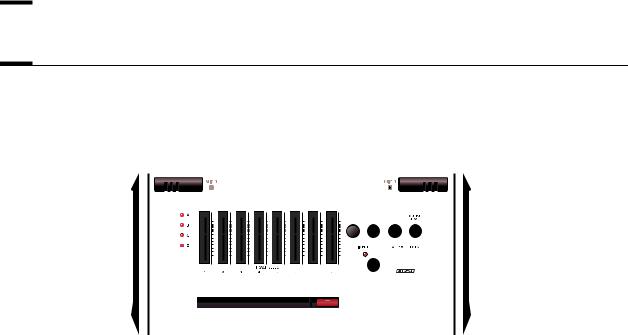

 Checking the Contents of the Package
Checking the Contents of the Package
As soon as you open the package, check that you have all of the included items.
If anything is missing, contact your dealer.
V-STUDIO 20 Hardware
Owner’s Manual
This is the manual you’re reading. It explains how to get V-STUDIO 20 up and running. It also explains what you need to know when setting up this product, and what you should know when using it. Keep this manual at hand for reference.
V-STUDIO 20 DVD-ROM
This DVD-ROM contains Guitar Tracks 4 and VS-20 USB Drivers.
USB cable
Use this cable to connect the V-STUDIO 20 hardware to the USB connector of your computer.
V-STUDIO 20 USB Setup sheet
This is an easy manual for the setup of the VS-20.
Customer service leaflet
This tells you where to direct your questions about operation.
10


 Installation and Registration
Installation and Registration
Here’s how to install the VS-20 driver and Guitar Tracks 4 on your computer.
DO NOT CONNECT THE VS-20 Hardware to your computer until the installer asks you too.
Guitar Tracks 4 cannot be installed unless the VS-20 driver is installed first.
Please note before installing
When installing, you must log on as a user with administrative privileges
In order to install Guitar Tracks 4, you must log on as a user who has administrative privileges. Once installed, the program can also be used by users who do not have administrative privileges.
Close system monitoring software before installing
If system monitoring software such as anti-virus programs are installed on your computer, you must close them until you’ve finished installing Guitar Tracks 4. You must also remember to close applications that are not shown in the Windows taskbar.
Installing the VS-20 Driver
What is a Driver?
A driver is software that transfers data between the V-STUDIO 20 hardware and application software on your computer when your computer and the V-STUDIO 20 hardware are connected via a USB cable. You will need to install the driver before connecting the V-STUDIO 20 hardware with your computer.
Log on to Windows as “Administrator”, or with an account that has administrator rights.
•Windows 7 and Windows Vista Users:p. 12
•Windows XP Users:p. 14
11
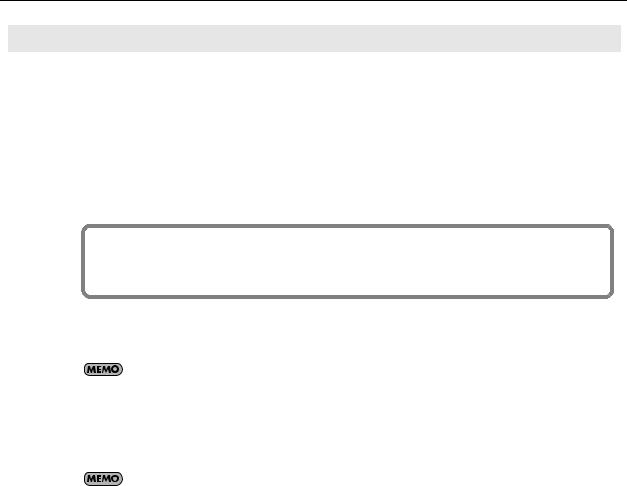
Installation and Registration
Windows 7/Vista Users
1.Disconnect all USB cables (except those for a USB keyboard and/or USB mouse, if used), then start up Windows.
2.Close all currently running software (applications).
Also close all windows that are open. If you are using software such as antivirus programs, be sure to close these programs as well including any monitoring software such as anti-virus programs.
3.Insert the included “V-STUDIO 20 DVD-ROM” into your computer’s DVD-ROM drive.
If you are using a Netbook or do not have a DVD-ROM drive, please visit http://www.cakewalk.com/register
to register your product and download the software installers included on the V-STUDIO 20 DVD-ROM.
4.Select “Start-Run” and enter “d:\Drivers\win7\setup.exe” to start the driver installer.
(where d:\ is your disc drive.)
Please be sure to select the correct driver for your operating system. x64 and x32 drivers are included on the DVD-ROM.
•x64Drivers\Win7 folder (for Windows 7 64-bit)
•Drivers\Win7 folder (for Windows 7 32-bit)
•x64Drivers\Vista folder (for Windows Vista 64-bit)
•Drivers\Vista folder (for Windows Vista 32-bit)
If a message informs you that “Driver installation must be performed by an administrator,” you must log on to Windows as a user whose Account Type is Administrator, and then perform the installation.
5.A confirmation screen regarding User Account Control appears, click [Continue].
6.The message “VS-20 Driver will be installed on your computer.” appears. Click [Next].
* If any other message appears, follow the directions of the message.
7.Click [Next] to begin installation.
12
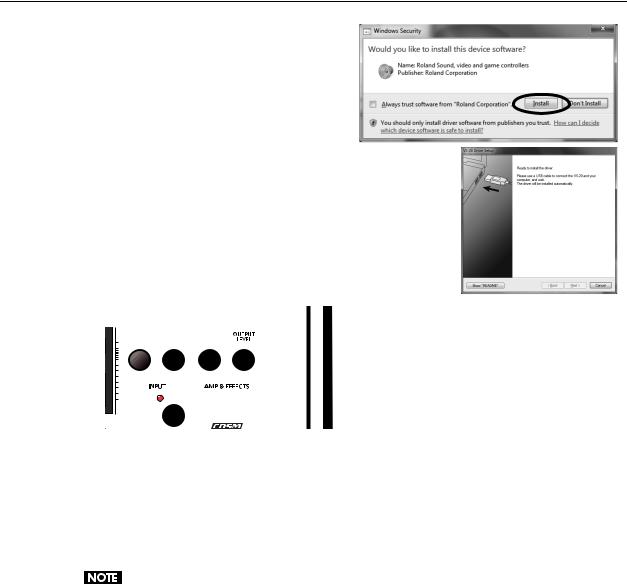
Installation and Registration
8.If a dialog box regarding Windows Security appears, click [Install].
9.The message “Ready to install the driver.” appears.
Leave the screen open; do not close it at this point.
* If any other message appears, follow the directions of the message.
10.Perform the following procedure before you connect the VS-20 Hardware to your computer.
1.Minimize the V-STUDIO 20 hardware’s [OUTPUT LEVEL] knob.
DIRECT
2.Use the included USB cable to connect the V-STUDIO 20 hardware to your computer.
3.The lower right corner of the screen will indicates “Installing device driver software,” and the driver will be installed automatically.
* If any other message is displayed, note the contents and close the message.
4.When the “Installation has been completed.” message appears, installation has been completed. Click [Close] to close the “Driver Setup” dialog box.
5.If the “System Settings Change” dialog box appears, click [Yes] to restart Windows.
It is very important the driver is installed successfully before installing other components. Please be sure to follow all instructions and verify the “Installation has been completed” messages appears before continuing. If the installation was not completed successfully, disconnect the USB cable from the V-STUDIO 20 hardware, and uninstall the driver by executing “Uninstall”, found in the same folder as the driver setup. Then install the driver once again, being careful to follow the instructions for the installation procedure.
13
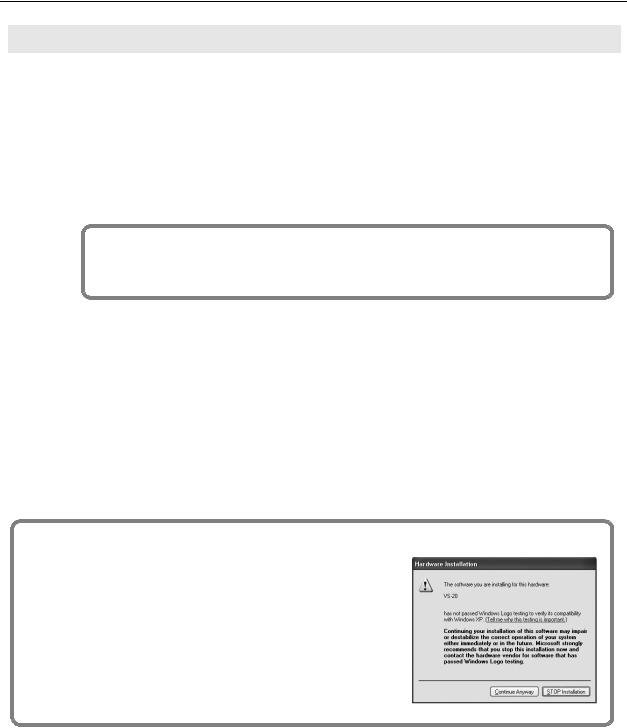
Installation and Registration
Windows XP Users
1.Disconnect all USB cables (except those for a USB keyboard and/or USB mouse, if used), then start up Windows.
2.Close all currently running software (applications).
Also close all windows that are open. If you are using software such as antivirus programs, be sure to close these programs as well.
3.Insert the included “V-STUDIO 20 DVD-ROM” into your computer’s DVD-ROM drive.
If you are using a Netbook or do not have a DVD-ROM drive, please visit http://www.cakewalk.com/register
to register your product and download the software installers included on the V-STUDIO 20 DVD-ROM.
4.Select “Start-Run” and enter “d:\Drivers\XP\setup.exe” to start the driver installer.
(where d:\ is your disc drive).
* If a “Install Program As Other User” dialog box appears, click [Cancel] to quit the installation and then perform the installation as an administrative account.
5.The message “VS-20 Driver will be installed on your computer.” appears. Click [Next].
* If any other message appears, follow the directions of the message.
6.Click [Next] to begin installation.
* If the “Software Installation” dialog box appears, click [Continue Anyway] to proceed with the installation.
If the “Driver Signing Options” setting was not set to “Ignore,” a “Hardware Installation” dialog box appears.
A dialog box with a “!” symbol appears.
1.Click [Continue Anyway] and continue the installation.
A dialog box with a “x” symbol appears.
1.Click [OK].
2.When the “Found New Hardware Wizard” appears, click [Finish].
3.Return to step 1 (p. 14) and re-install the driver from the beginning of the procedure.
14

Installation and Registration
7.The message “Ready to install the driver.” appears.
Leave the screen open; do not close it at this point.
* If any other message appears, follow the directions of the message.
8.Perform the following procedure before you connect the VS-20 Hardware to your computer.
1.Minimize the V-STUDIO 20 hardware’s [OUTPUT LEVEL] knob.
DIRECT
2.Use the included USB cable to connect the V-STUDIO 20 hardware to your computer.
3.Wait until the lower right of the screen indicates “Found New Hardware” and the “Found New Hardware Wizard” appears.
* It may take some time for the “Found New Hardware Wizard” to appear.
4.If you are asked whether you want to connect to Windows Update, choose “No” and then click [Next].
5.Choose “Install the software automatically (Recommended)” and click [Next].
6.If the “Hardware Installation” dialog box appears, click [Continue Anyway] to proceed with the installation.
*If you cannot proceed with the installation, click [OK] to cancel the installation, and then refer to “Driver Signing Options setting.”
7.If the “Completing the Found New Hardware Wizard” appears, Click [Finish].
When the “Installation has been completed.” message appears, installation has been completed. Click [Close] to close the “Driver Setup” dialog box.
8.If the “System Setting Change” dialog box appears, click [Yes] to restart Windows.
It is very important the driver is installed successfully before installing other components. Please be sure to follow all instructions and verify the “Installation has been completed” messages appears before continuing. If the installation was not completed successfully, disconnect the USB cable from the V-STUDIO 20 hardware, and uninstall the driver by executing “Uninstall”, found in the same folder as the driver setup. Then install the driver once again, being careful to follow the instructions for the installation procedure.
15
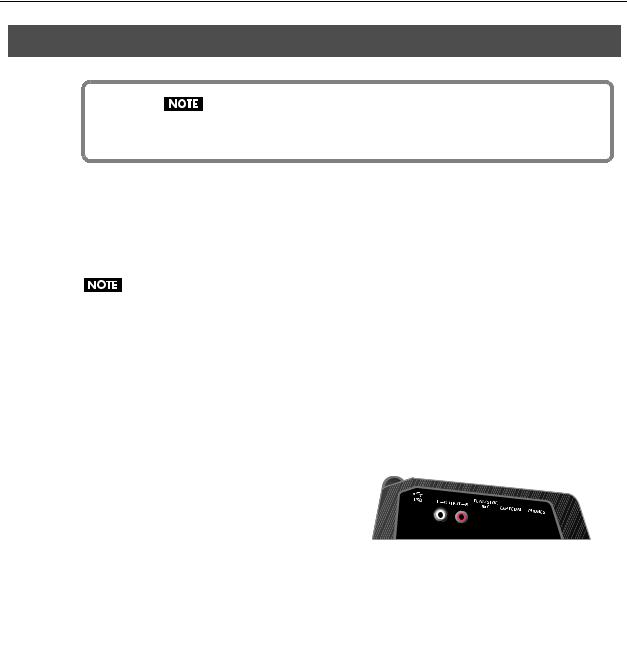
Installation and Registration
Connecting your audio equipment
Before connecting the VS-20 Hardware to a computer, read the Installing the VS-20
Driver (p. 11) and install the VS-20 driver on the computer. If the driver is not installed,
Guitar Tracks 4 cannot be operated correctly from the computer.
•Use a USB cable to connect your computer to the VS-20 Hardware.
•Connect your audio output devices such as headphones or speakers to the VS-20 Hardware. * This package does not include sound reproduction equipment such as headphones or speakers.
You must connect headphones or monitor speakers as shown in the illustration, monitor the playback audio from the V-STUDIO 20.
To prevent malfunction and/or damage to speakers or other devices, always turn down the volume, and turn off the power on all devices before making any connections.
Monitor amplified speakers
Headphones
USB
Cable
Computer
16
